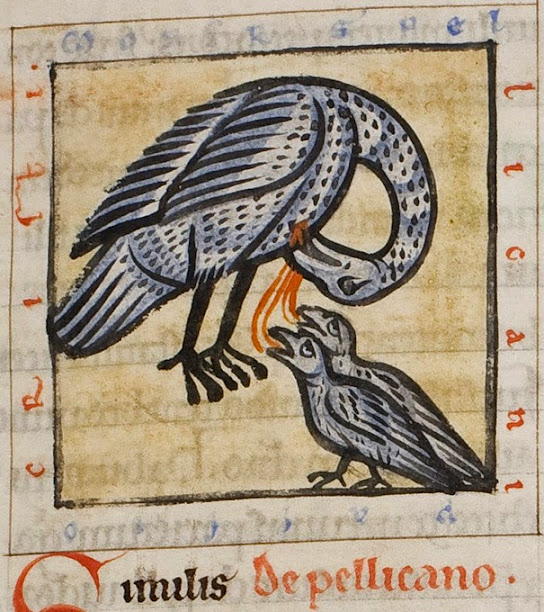Another project can be revealed! A number of months ago I was approached by a friend to do embroidery for a Pelican cloak* for her husband. She gave me the date of the planned event, and I consulted my calendar.
Now, as those who follow this blog probably know, I am working on projects which will be the body of supporting work when I present for Expert ranking some time this summer in the East Kingdom embroidery guild Keepers of Athena's Thimble in the Couching and Laid work category. Since as much of my work as possible needs to be towards that end, I suggested an embroidery that would apply, and my friend agreed.

Next was research. There are a number of pelican in piety images that are commonly used in the SCA, but I wanted something a little different. The recipient has a 12th Century persona, so I went looking for a 12th Century depiction of the pelican. I found a lovely website with lots of pelican pictures:
http://bestiary.ca/beasts/beastgallery244.htm. Among the pictures was this one, which simply called out to me.
It is from MS 89/54, Folio 6, Groosteminarie Library, Bruges, which contains an Aviary of Hugh of Fouilloy, dated to ca. 1190-1200. I suggested to my friend two small medallions on the shoulders of the cloak based on this illustration, reversed to face each other, done in the laid and couched technique known as convent stitch.
No, convent stitch is not actually period to the time of the illustration -- this was an "SCA stretch." It was, however the only way I could fit doing this project in my time schedule and she was happy with the presented design and plan.
I used some nice sturdy linen from my stash and Splendor silks to execute the design. My "artist" was, as in many of my projects, a good clear print out of the source picture traced, then copied at ratio to fit the size desired and reversed, also on the copier. This was in lieu of my own art skills (negligible, tracing is kind of the limit of it), and an in house artist.

First, the outlines, ribbons of blood and feet were done in stem stitch. I used two strands of splendor for the outlining. I used a lighter shade for the outlines of the baby birds than for the mother bird. Should I do such a project again, I would use the same for both, as I think there is not quite enough contrast on the baby birds from a distance.

Anyone else thinking "vampire birds" here?
Next, I filled the bird bodies with convent stitch, using a lighter shade in each instance. One aspect of convent stitch that was interesting to me is that it is all straight up and down. Unlike other embroidery forms, even other laid and couched forms, there is no definition provided by using different directions.

Next, a nice deep blue (chosen in conference with my friend) for filling in the background. It wasn't until I was nearly done filling in the first one that it occurred to me to mark the couching lines. and now the babies have no legs.
Neither of those bother me much, Most people will see these from a distance. This is primarily a ceremonial item, and only those who are really good friends will be close enough to see that the lines are not perfectly straight.
I did find that silk does not really want to play at convent stitch. Wool, which is the fiber used in many extant pieces, would "fluff up" and fill in for better coverage than the silk. I compensated by taking extra stitches after an area was done if I felt the couching had opened up the laid stitches to allow too much of the background through.
The final touch was dark gold chain stitch around the outline, which added a pop of color, a good sewing place for mounting, and helped to even off the edges a little bit.
My friend brought over the cloak that had been made by someone else (and a lovely cloak it is, too), and I hung it on my dress form and positioned the medallions. I carefully whip stitched them in place, catching only the cloak (not the lining) all the way around.
Now that it has been presented, the recipient and I will get together at some point, with him in appropriate garb, to check the positioning and adjust if necessary. I'll try to get some good shots of him in the cloak and do a follow up post.
Another really cool aspect is that part of the elevation includes a scroll -- here is a picture of the scroll done by Natalia Anastasiia Evgenova -- she used the same illustration. No, we didn't coordinate that! I'm going to call it "great minds thinking alike!"
 |
| Photo by Photo by Constable Calin Macsalny of Barony Bhakail |
*Yes, this is an SCA thing. For those not in the SCA, the Order of the Pelican is the society wide honor given for service. Typically a cloak or other outer garment is given, usually with a depiction of a "pelican in her piety."








































